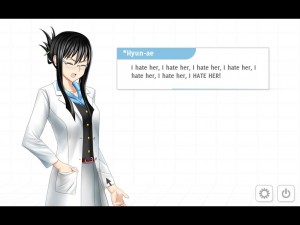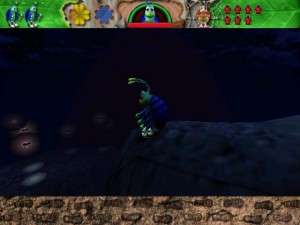 Christine Love’s hate story is of course a follow-up to her BBS novella Digital: A Love Story, although set centuries later, in what is only minimally implied to be the same world. My first reaction to it is that it is Portal (Activision, 1986) done right. Seriously, the parallels between the two works run far, if not deep. Both are primarily text-based works with multi-leveled narratives concerning a mysteriously vanished population and the player character’s attempts to recover its history from computer records, aided by an AI guide who unearths more records in response to your reading what’s already been presented. And both are only hesitantly identified by their creators as games. As Love put it in a recent interview: “I always thought that I’d just end up being a novelist. Then everyone told me that Digital: A Love Story was a game, just because it had interactive elements…”
Christine Love’s hate story is of course a follow-up to her BBS novella Digital: A Love Story, although set centuries later, in what is only minimally implied to be the same world. My first reaction to it is that it is Portal (Activision, 1986) done right. Seriously, the parallels between the two works run far, if not deep. Both are primarily text-based works with multi-leveled narratives concerning a mysteriously vanished population and the player character’s attempts to recover its history from computer records, aided by an AI guide who unearths more records in response to your reading what’s already been presented. And both are only hesitantly identified by their creators as games. As Love put it in a recent interview: “I always thought that I’d just end up being a novelist. Then everyone told me that Digital: A Love Story was a game, just because it had interactive elements…”
So, what does Analog get right that Portal didn’t? Nonlinearity, for one thing. Like the long novels of old, it contains digressions that illuminate the main plot, but aren’t essential to it, and thus can be encountered at whatever point in the storyline you become curious enough to pursue them, if at all. (Actually unlocking 100% of the text items in this game grants an Achievement on Steam, and it’s an Achievement I haven’t gotten yet despite reaching three different endings.) These take the form of diaries or letter exchanges between various long-dead persons that the AI thinks will interest you, or which will illustrate a point. Like Digital, this is mainly an epistolary novella, and that’s another point that’s an improvement over Portal. Instead of using the AI guide as an interpreter of data with a purportedly neutral point of view, you get the raw source material plus the AI’s interpretation, and get to decide for yourself how much you agree with it.
For your guide doesn’t just have a point of view, she has outright biases. Mind you, they’re biases that no reasonable modern person would disagree with. (You get opportunities to act as if you do, but that’s bound to be role-playing.) The basic idea — and I’m delving deep into spoilers here — is that society on the generation ship you’re investigating had regressed to a monstrously oppressive set of antiquated traditions, specifically those of Korea’s Joseon dynasty, in which women in particular are as a whole no better off than slaves, barely regarded as human and valued only as instruments for producing male heirs. The first AI you meet, *Hyun-ae , is actually the digitized personality of a more modern person, a teenage girl brought out of cryo-stasis during this period, repeatedly punished for not being submissive enough, and expected to immediately marry against her will. When she pleaded for her independence, the whole notion was so alien to her family-cum-captors that they could only interpret it as a rebellious and unfilial declaration that she wanted to become a prostitute and bring shame on the family name.
Still, as much as you might feel sorry for Hyun-ae, it’s clear that *Hyun-ae is providing you information selectively, even hiding things from you, in the hope of maintaining your goodwill. There’s a particular technique used in the dialogue : sometimes *Hyun-ae will start to say something and then instantly erase part of it. (You have to let the text scroll in, rather than click to make it appear all at once, to notice this.) Also, one of the first text items you uncover is a message from the ship’s previous controlling AI, named *Mute. If you show this to *Hyun-ae, she immediately deletes it. This is all to the good of the work. Secret agendas just make seemingly-friendly NPCs more interesting, as anyone who’s played Planescape: Torment can tell you. But it’s easy to excuse her, because it’s clear that her experiences have made her cagey. She doesn’t fully trust you, doesn’t know if you share the neo-Joseons’ world-view or not.
In the second act, you get to reactivate *Mute, who immediately presents the devil’s advocate position. *Mute is unapologetically in favor of the status quo, dismal subjugation of half the population and all, and furthermore is kind of catty and sleazy about it: when she shares her digressive epistolary tales of tragically unhappy marriages, it’s for the sake of the pleasure of being aghast at how scandalous they are. So you’ve basically got a good girl and a bad girl at this point, except that this is also the chapter where you learn that it was Hyun-ae who killed everyone on the ship.
And most of the rest of the work is spent exploring that in one way or another. You’ve presumably already come to sympathize with *Hyun-ae by this point, but does that extend to forgiving genocide? Admittedly, she was sorely provoked. But slaughtering oppressors and oppressed alike? Ah, but the story points out that the oppressed had internalized their oppression, and were just as culpable as anyone of perpetuating it. Perhaps when a dystopia gets bad enough, blowing the airlocks is the only way out. True, the historical precedent in the Joseon dynasty — which, according to the endnotes, was even worse than what’s seen in the story here — didn’t last forever. But it did last a long time, and Korea at least was part of a world that was generally advancing, while the generation ship is portrayed as stagnant and degenerating in knowledge.
But frankly, I don’t think such considerations are all that relevant to what decisions most players will make. The fact is, *Hyun-ae is a love interest — as the author puts it in the interview cited above, “Analogue is a game where a survivor of horrific trauma falls in love with the first person she meets”. This is very clear from her behavior, and becomes increasingly clear as the story goes on. In the majority of the occasions where she deletes what she’s said, it’s because she’s stated her feelings too directly. And everyone loves a love story, or at least cooperates with one. This is a lesson I think was most clearly taught by Andrew Plotkin’s So Far (which I will now spoil). So Far is a mysterious and surreal text adventure dominated by a repeated motif of things that have to be kept apart, because things will go disastrously wrong if they’re allowed contact. It ends with a question — “Can you forgive me?” — that, in context, signifies an opportunity to reconcile estranged lovers. Despite everything that the player has learned about how the game works, nearly everyone says “yes” to this the first time they encounter it. If we unthinkingly respond this way in a game that’s doing so much to allow us to realize that it’s the wrong choice, what are the odds we’ll choose any differently in one that’s trying to convince us that the computer has a crush on us?
 Comments(4)
Comments(4)
